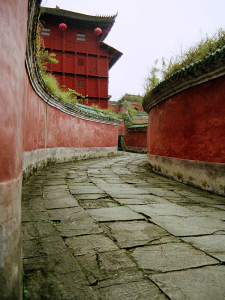The Tai Chi Classics
 The Tai Chi Classics provide the principles for identifying and learning Tai Chi Chuan.
The Tai Chi Classics provide the principles for identifying and learning Tai Chi Chuan.
There are many stories about the beginnings of Taiji, and there is some evidence Taiji Quan was originally developed by Daoist Qi Gong Masters.
The Daoist masters focused their efforts on increasing health, extending lifespan, seeking harmony with nature and gaining enlightenment through the cultivation and development of Qi and Shen (Spirit). Tai Chi Chuan appears to have evolved from those efforts, as their Neigong practices led to development of the basic postures and movements that eventually became Taiji Quan. Nearing the end of the Song Dynasty Chang San Feng (Zhang Sanfeng), further developed the practice that has grown through an unbroken lineage into an advanced form of internal martial art, Tai Chi Chuan (Taiji Quan, which means Supreme Ultimate Fist).
Taiji Quan, by design, promotes health, longevity, self-defense capability and potentially may lead the practitioner to enlightenment. In order to achieve the higher levels and benefits of Taiji Quan it is important to gain a personal knowledge and understanding of the martial, energetic and spiritual aspects of the art. This occurs over years of diligent practice and right application of the principles with the assistance of a qualified teacher.
The beginnings of the Tai Chi Classics are attributed to the legendary founder of tai chi chuan, Chang San Fang at some point during the 12th-14th century. The Taiji classics have been further elucidated by the Yang Family teachings and writings. Even though we may never fully know the origin of the classics they provide the principles and methods for developing the internal martial art of Tai Chi Chuan, whether we practice Chen, Yang, Wu, Sun etc. all follow the principles put forth in the Tai Chi Classics.
A few examples from the Taiji Classics:
- You should be still as a mountain and move like a great river.
- The head is suspended from above like a wind chime hanging from the ceiling and the body is upright, stable, and comfortable with an aware mind.
- When any part of the body/mind moves there is no part that does not move.
- When the body/mind is still, there is no part that is not still.
The form should have the appearance of a hawk gliding in search of its prey. Internally the heart/mind (Yi) should be like that of a cat ready to pounce on its prey. - Four ounces are able to deflect a thousand pounds.
These guidelines provide principles, images and goals for the practitioner to cultivate their internal martial art practice.
Learn more about the Tai Chi Classics through our links and resources pages.
